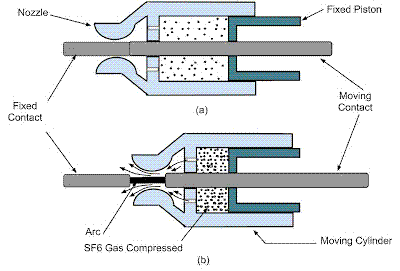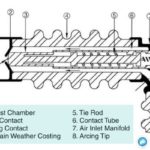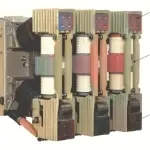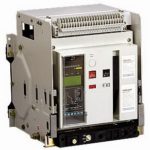Definition
A circuit breaker means the device which breaks (Open) the circuit under the abnormal condition and protects the system from hazards.
The function of a circuit breaker is to isolate the faulty point of the power system in case of abnormal conditions such as faults.
Keep reading to understand the working principle of the circuit breaker.
Different types of circuit breakers are used to perform this function. There are low voltage circuit breakers and high voltage circuit breakers. High voltage circuit breakers are mainly used in substation and low voltage CB are used in home circuits.
Important high voltage circuit breakers used in the electrical substation are
Low voltage CB includes
- Miniature Circuit breaker (MCB),
- Molded Case Circuit Breaker (MCCB),
- Residual Current Circuit breaker (RCCB) or
- Ground Fault Circuit Interrupter (GFCI)
A protective relay is another important device in the power system switchgear. Relay detects abnormal conditions and sends a tripping signal to the circuit breaker. After receiving the tripping command from the relay, the circuit breaker isolates the faulty part from the power system.
A circuit breaker essentially consists of fixed and moving contacts, called electrodes. These contacts are placed in the closed chamber containing a fluid containing medium (either liquid or gas) which quenches the arc formed between the contacts.
Under normal operating conditions, these contacts remain closed and will not open automatically until and unless the system becomes faulty.
The contacts can be opened manually or by remote control whenever desired.
When a fault occurs on any part of the system, the trip coils of the breaker get energized. The moving contacts are pulled apart by some mechanism, thus opening the circuit.
Circuit Breaker Working Principle
The working principle of the circuit breaker is explained in this section.
When the contacts of a circuit breaker are separated under fault conditions, an arc is struck between them. The current is thus able to continue until the discharge ceases.

The production of arc not only delays the current interruption process but it also generates enormous heat. This heat may cause damage to the system or to the breaker itself.
Therefore, the main problem in a circuit breaker is to extinguish the arc within the shortest possible time. So that heat generated by it may not reach a dangerous value.
Arcing Phenomenon in Circuit Breaker
At the instant when the contacts begin to separate the contact area decreases rapidly. Also, a large fault current causes increased current density and hence rise in temperature.
The potential difference between the contacts is quite small and is just sufficient to maintain the arc. The arc provides a low resistance path and consequently, the current in the circuit remains uninterrupted so long as the arc persists.
During the arcing period, the current flowing between the contacts depends upon the arc resistance. The greater the arc resistance, the smaller the current that flows between the contacts.
The arc resistance depends upon the following factors:
The degree of ionization – the arc resistance increases with the decrease in the number of ionized particles between the contacts.
Length of the arc – the arc resistance increases with the length of the arc i.e. separation of contacts.
Cross-section of arc – the arc resistance increase with the decrease in the area of cross-section of the arc.
Methods of Arc Extinction in Circuit Breaker
There are two methods of extinguishing the arc in circuit breakers
- High resistance method
- Low resistance or current zero method.
High Resistance Method
In the High resistance method, arc resistance is made to increase with time so that current is reduced to a value insufficient to maintain the arc. Consequently, the current is interrupted or the arc is extinguished.
The principal disadvantage of high resistance method is that enormous energy is dissipated in the arc. Therefore, it is employed only in DC circuit breakers and low-capacity AC circuit breakers.
Low Resistance or Current Zero Method
Current zero method is employed for arc extinction in AC Circuits only.
In this method, arc resistance is kept low until the current zero where the arc extinguishes naturally and is prevented from restriking in spite of the rising voltage across the contacts.
All modern high power AC Circuit Breakers employ this method for arc extinction.
Types of Circuit Breaker
The basic types of circuit breakers according to the medium of arc interruption are







